Lecture 3. Things to do in class.
Contents
Number 1
- Get 1D 2nd-order differentiation matrix. For this particular problem, since a=c, b=d, n = m and hx = hy = h, we can use the same 1D differentiation matrix, i.e Dx=Dy=D1.
clear all; close all; % clear all to start fresh a = -1; b = 1; n = 10; h = (b-a)/(n-1); one = ones(n,1); % create a column vector of size n by 1 of ones D1 = spdiags([-one one],[-1 1],n,n); D1(1,1:3) = [-3 4 -1]; D1(end,end-2:end) = [1 -4 3]; % Modify first and last row (one-sided weights) D1 = (0.5/h)*D1; % Don't forget the 1/(2*h) factor spy(D1) % Plot the structure of the sparse matrix
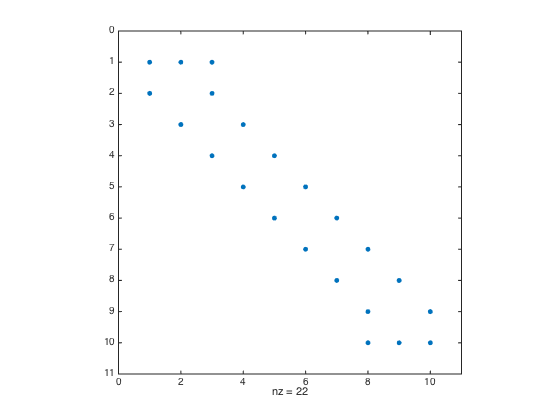
- Create Tensor Product Grid
x = linspace(a,b,n).'; % Create n equally-spaced points in [a,b] y = x; % set y = x [X,Y] = meshgrid(x,y); figure mesh(X,Y,0*X); view(2); % plot the grid
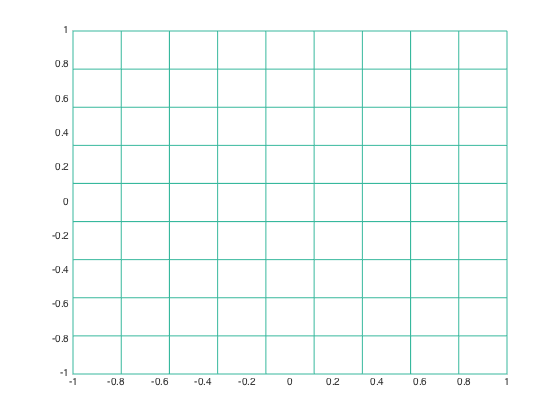
- Create differentiation matrices. Here, I am doing Dx and Dy for you. Can you create the Laplacian operator ?
I = speye(n); % Create sparse identity matrix
Dx = kron(D1,I);
Dy = kron(I,D1);
figure;
subplot(1,2,1); spy(Dx);
subplot(1,2,2); spy(Dy);
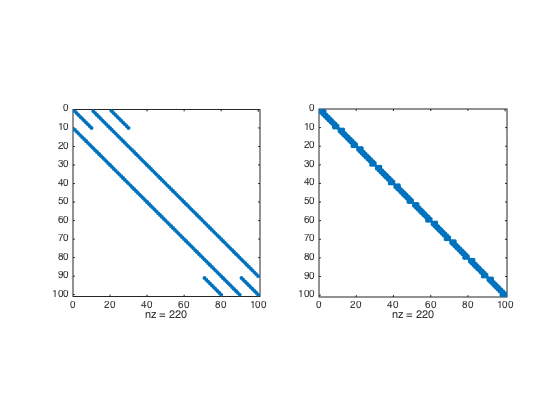
Number 2
format long e % format number in long format u = @(x,y) exp(-(x.^2+0.5*y.^2)); % Define the function ux = @(x,y) -2*x.*exp(-(x.^2+0.5*y.^2)); % Define the exact u_x of the function uy = @(x,y) -y.*exp(-(x.^2+0.5*y.^2)); % Define the exact u_y of the function
- Compute derivative in matrix way (without kronecker product and without linear indexing). Here I am doing Ux and Uy for you. Can you compute the Laplacian ?
U = u(X,Y); % Function values at nodes Ux = U*D1.'; % U_x = U*transpose(D) Uy = D1*U; % U_y = D*U norm(Ux(:)-ux(X(:),Y(:)),Inf) norm(Uy(:)-uy(X(:),Y(:)),Inf) figure subplot(1,2,1); surf(X,Y,Ux); xlabel('x'); ylabel('y'); zlabel('U_x'); subplot(1,2,2); surf(X,Y,Uy); xlabel('x'); ylabel('y'); zlabel('U_y');
ans =
4.326197654789388e-02
ans =
2.179530238274729e-02
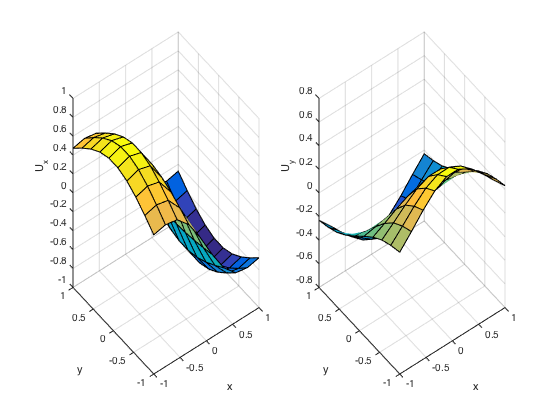
- Compute derivatives with kronecker product way and with linear indexing.
Ux = Dx*U(:); Uy = Dy*U(:); norm(Ux-ux(X(:),Y(:)),Inf) norm(Uy-uy(X(:),Y(:)),Inf)
ans =
4.326197654789388e-02
ans =
2.179530238274729e-02
Number 3
For 2nd order convergence, slope must be 2.
n = 10:100:1100; % Create n = 10,110,210,310,... h = (b-a)./(n-1); err = zeros(length(n),2); % Pre-allocate memory to store errors for i=1:length(n) one = ones(n(i),1); D1 = spdiags([-one one],[-1 1],n(i),n(i)); D1(1,1:3) = [-3 4 -1]; D1(end,end-2:end) = [1 -4 3]; D1 = (0.5/h(i))*D1; x = linspace(a,b,n(i)).'; y = x; % set y = x [X,Y] = meshgrid(x,y); U = u(X,Y); % Function values at nodes Ux = U*D1.'; % U_x = U*transpose(D) Uy = D1*U; % U_y = D*U err(i,1) = norm(Ux(:)-ux(X(:),Y(:)),Inf); % Store err of ux in 1st col err(i,2) = norm(Uy(:)-uy(X(:),Y(:)),Inf); % Store err of uy in 2nd col end figure loglog(h,err(:,1),'-o',h,err(:,2),'-*r') % Plot the errors in logscale xlabel('h'); ylabel('Error')
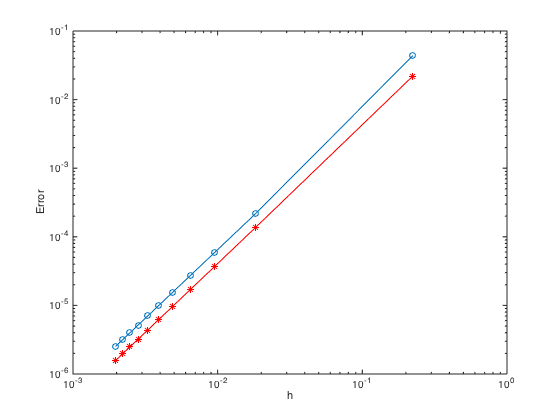
Number 4
Please do it yourself. Should be easy if you understand and did (1)-(3) correctly.